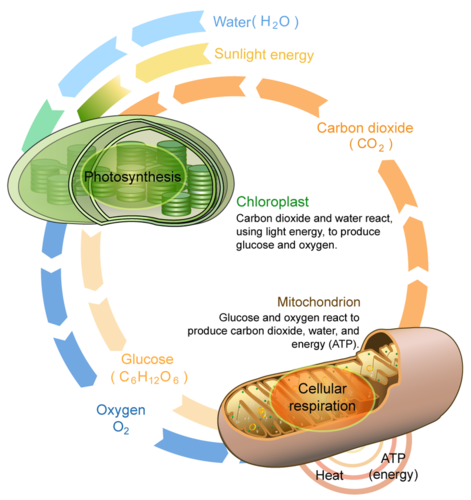
How do trees help you breathe?
Recall that trees release oxygen as a byproduct of photosynthesis. And you need oxygen to breathe. Do you know why? So your cells can perform cellular respiration.
Connecting Cellular Respiration and Photosynthesis
Photosynthesis and cellular respiration are connected through an important relationship. This relationship enables life to survive as we know it. The products of one process are the reactants of the other. Notice that the equation for cellular respiration is the direct opposite of photosynthesis :
- Cellular Respiration: C 6 H 12 O 6 + 6O 2 → 6CO 2 + 6H 2 O
- Photosynthesis: 6CO 2 + 6H 2 O → C 6 H 12 O 6 + 6O 2
Photosynthesis makes the glucose that is used in cellular respiration to make ATP. The glucose is then turned back into carbon dioxide, which is used in photosynthesis. While water is broken down to form oxygen during photosynthesis, in cellular respiration oxygen is combined with hydrogen to form water. While photosynthesis requires carbon dioxide and releases oxygen, cellular respiration requires oxygen and releases carbon dioxide. It is the released oxygen that is used by us and most other organisms for cellular respiration. We breathe in that oxygen, which is carried through our blood to all our cells. In our cells, oxygen allows cellular respiration to proceed. Cellular respiration works best in the presence of oxygen. Without oxygen, much less ATP would be produced.
Cellular respiration and photosynthesis are important parts of the carbon cycle. The carbon cycle is the pathways through which carbon is recycled in the biosphere. While cellular respiration releases carbon dioxide into the environment, photosynthesis pulls carbon dioxide out of the atmosphere. The exchange of carbon dioxide and oxygen during photosynthesis (Figure below ) and cellular respiration worldwide helps to keep atmospheric oxygen and carbon dioxide at stable levels.

Cellular respiration and photosynthesis are direct opposite reactions. Some of the ATP made in the mitochondria is used as energy for work, and some is lost to the environment as heat.
Here is a fun video on photosynthesis and cellular respiration. Stop at time 3:32
Amazing Project by one of our past students!





















